NCERT Solutions For Class 10 Science Chapter 2 – CBSE Term I Get Free PDF
NCERT Solutions for Class 10 Science Chapter 2 Acids, Bases and Salts are prepared to help students in their CBSE Term I exam preparation. This solution provides you with answers to the questions provided in the NCERT Class 10 textbooks. To score better marks in the Class 10 Science Term I examination students should get well versed with the NCERT Solutions for Class 10 Science provided here.
In this chapter, students will learn about the nature and behaviour of Acids, bases and salts. This chapter mainly describes the chemical nature of acids, bases and salts, their reaction with metals, non-metals and with each other. It’s highly suggested that students make use of the NCERT Solutions for Class 10 Science Chapter 2 while learning the main concepts. Also, this chapter is quite interesting as it involves many practical experiments to help you learn the basics.
Every year 3 – 4 questions from this chapter are asked in the Class 10 examination. This is also one of the important chapters as the chances of scoring full marks on questions from this chapter are more. Hence, students are advised to practise all questions of this chapter using these NCERT Solutions for Class 10 Science. Access the NCERT Solutions of Class 10 Science of this chapter from the link enclosed below.
Practical based multiple choice questions and subjective based questions are regularly asked in previous year question papers.
Download PDF of NCERT Solutions for Class 10 Science Chapter 2 – Acids Bases and Salts
Access Answers to NCERT Class 10 Science Chapter 2 – Acids Bases and Salts
In-text questions set 1 —> Page number 18
1. You are given three test tubes. The three test tubes contain distilled water, acidic solution and the basic solution respectively. There is only red litmus paper available in order to identify what is there in each test tube. How will you find out what is in each of the test tubes?
Solution: We can identify the content in each of the test tubes using red litmus paper. This can be done by noticing the colour change of the red litmus paper.
- On litmus paper, the three solutions in the test tubes are poured separately.
- The solution which turns red litmus to blue contains a basic solution.
- Divide the formed blue litmus paper into two parts.
- The solution from the test tube which turns blue litmus paper to red will be the acidic solution.
- Solution of the test tube which do not change either red or blue litmus paper contain water.
NOTE: After immediate distillation, distilled water has a pH of 7. However, just within a few hours after distillation, it absorbs carbon dioxide from the atmosphere and turns slightly acidic with a pH of 5.8.
In-text questions set 2 —> Page number 22
1. Why should curd and sour substances not be kept in brass and copper vessels?
Solution: Curd and sour food substances contain acids; these acidic substances combine with metal. This reaction turns food to poison which damage people’s health.
2. Which gas is usually liberated when an acid reacts with a metal? Illustrate with an example. How will you test for the presence of this gas?
Solution: When an acid reacts with any metal, salt and hydrogen gas are formed.
Metal + Acid → Salt + Hydrogen gas
3. Metal compound A reacts with dilute hydrochloric acid to produce effervescence. The gas evolved extinguishes a burning candle. Write a balanced chemical equation for the reaction if one of the compounds formed is calcium chloride.
Solution: As metal compound released is Calcium Chloride the gas evolved here is CO2. Hence metal A should be Calcium Carbonate. Hence the reaction between Calcium Carbonate and HCl is
CaCO3 (s) + 2HCl (Aq) → CaCl2( Aq) + CO2 (g) + H2O (l)
in text questions set 3 Page number – 25
1. Why do HCl, HNO3, etc., show acidic characters in aqueous solutions while solutions of compounds like alcohol and glucose do not show acidic character?
Solution: Release of H+ ion in water will make a compound acidic or non-acidic. Acids are the substance which upon dissociating with water results in production of Hydrogen ions. Some compounds show acidic character as they dissociate in the aqueous solution which results in the production of hydrogen ions (acids like HCl, HNO3).
Compounds similar to glucose or alcohol do contain hydrogen element but they do not show signs of acidic nature. The fact that the hydrogen in them will not separate as like the hydrogen in the acids. They will not separate to become hydrogen ions, on dissolving in the water.
2. Why does an aqueous solution of an acid conduct electricity?
Solution: Charged particles are responsible for the conductance of electricity in an acid. These charged particles called as ions are the reason behind conductance of electricity in acid.
3. Why does dry HCl gas not change the colour of the dry litmus paper?
Solution: HCl does not give out Hydrogen ions, therefore HCl does not show any acidic behaviour and colour of the litmus paper remain the same on reacting with HCl gas.
4. While diluting an acid, why is it recommended that the acid should be added to water and not water to the acid?
Solution: While diluting an acid, it is recommended that the acid should be added to water and not water to the acid because if water is added to concentrated acid, it release huge amount of heat which may result in explosion and can cause acid burns on face, clothes and body parts. Hence it is safe to add acid to water but not water to acid.
5. How is the concentration of hydronium ions (H3O+) affected when a solution of an acid is diluted?
Solution: When acid is added to water there will be a fixed amount of hydronium present in the fixed volume of solution. If we dilute the solution hydronium ion per volume of solution decrease, this in-turn decreases Hydronium concentration in the solution.
6. How is the concentration of hydroxide ions (OH–) affected when excess base is dissolved in a solution of sodium hydroxide?
Solution: When base is dissolved in sodium hydroxide solution its hydroxide ions increase but it will reach saturation at some point. After saturation point hydroxide ion concentration is not affected even after adding base further.
In-text questions set 4 Page number – 33
1. You have two solutions, A and B. The pH of solution A is 6 and pH of solution B is 8. Which solution has more hydrogen ion concentration? Which of this is acidic and which one is basic?
Solution: In order to find the hydrogen ion concentration, we can use the rule that states, “The pH of any solution is inversely proportional to the hydrogen ion concentration”. Therefore, it means that the solution that has a lower pH number will have a higher hydrogen ion concentration. Hence, solution A will have a higher hydrogen ion concentration. In addition, solution B will be basic and A will be acidic.
2. What effect does the concentration of H+(aq) ions have on the nature of the solution?
Solution: Hydrogen ion concentration decides the nature of the solution. If Hydrogen ion concentration increase then solution turn acidic and similarly if Hydrogen ion concentration decreases then solution turn basic.
3. Do basic solutions also have H+(aq) ions? If yes, then why are these basic?
Solution: Basic solutions has H+ ions, but hydroxide ions present in basic solution are more in basic solution. Hence Hydroxide ions turn solution to basic.
4. Under what soil condition do you think a farmer would treat the soil of his fields with quick lime (calcium oxide) or slaked lime (calcium hydroxide) or chalk (calcium carbonate)?
Solution: If the soil is acidic in nature (PH below 7) then such field should be treated with quick lime (calcium oxide) or slaked lime (calcium hydroxide) or chalk (calcium carbonate).
In text questions set 5 Page number – 34-35
1. What is the common name of the compound CaOCl2?
Solution: Common name of CaOCl2 is bleaching powder.
2. Name the substance which on treatment with chlorine yields bleaching powder
Solution: The substance which on treatment with chlorine yields bleaching powder is Calcium hydroxide.
3. Name the sodium compound which is used for softening hard water.
Solution: Sodium carbonate is the compound which is used for softening hard water.
4. What will happen if a solution of sodium hydrocarbonate is heated? Give the equation of the reaction involved.
Solution: Heating sodium hydrocarbonate yields sodium carbonate and carbon dioxide gas is liberated in the process.

5. Write an equation to show the reaction between Plaster of Paris and water.
Solution: The chemical equation for the reaction of Plaster of Paris and water is
CaSO4.1/2H2O + 3/2H2O → CaSO4.2H2O
Exercise questions Page number – 33
1. A solution turns red litmus blue, its pH is likely to be
a) 1 (b) 4 (c) 5 (d) 10
Solution: Answer is 10 because litmus paper turns blue when reacts with basic solution (PH more than 7). Hence 10 is the answer.

2. A solution reacts with crushed egg-shells to give a gas that turns lime-water milky. The solution contains
a) NaCl (b) HCl (c) LiCl (d) KCl
Solution: Answer is HCl.
Egg shells contains calcium carbonate, which on reaction with HCl liberates CO2 gas which turn lime water to milky.

CaCO3 + 2HCl → CaCl2 + H2O + CO2
3. 10 mL of a solution of NaOH is found to be completely neutralised by 8 mL of a given solution of HCl. If we take 20 mL of the same solution of NaOH, the amount HCl solution (the same solution as before) required to neutralise it will be
(a) 4 mL (b) 8 mL (c) 12 mL (d) 16 mL
Solution: Since 10 ml of NaOH requires 8 mL of HCL, 20 ml of NaOH require 8 x 2 = 16mL of HCl. Hence the answer is option d 16mL.

4. Which one of the following types of medicines is used for treating indigestion?
(a) Antibiotic (b) Analgesic (c) Antacid (d) Antiseptic
Solution: Indigestion is due to excess production of acid in the stomach. Medicines used to treat indigestion is called as Antacid.

5. Write word equations and then balanced equations for the reaction taking place when
(a) Dilute sulphuric acid reacts with zinc granules.
(b) Dilute hydrochloric acid reacts with magnesium ribbon.
(c) Dilute sulphuric acid reacts with aluminium powder.
(d) Dilute hydrochloric acid reacts with iron filings.
Solution:

(a) dilute sulphuric acid reacts with zinc granules:
=> dilute sulphuric acid + zinc → Zinc Sulphate + Hydrogen Gas
=> H2SO4(aq) + Zn → ZnSO4(aq) + H2(g)

(b) dilute hydrochloric acid reacts with magnesium ribbon.
=> dilute Hydrochloric + Magnesium → Magnesium Chloride + Hydrogen Gas
=> 2HCl(aq) + Mg → MgCl2(aq) + H2(g)

(c) dilute sulphuric acid reacts with aluminium powder.
=> dilute Sulphuric Acid + Aluminium → Aluminium Sulphate + Hydrogen Gas
=> 3H2SO4(aq) + 2Al(s) → Al2(SO4)3(aq) + 3H2(g)

(d) dilute hydrochloric acid reacts with iron filings.
=> dilute Hydrochloric Acid + Iron → Ferrous Chloride + Hydrogen Gas
=> 6HCl(aq) + 3Fe(s) → 3FeCl2(aq) + 3H2(g)

6. Compounds such as alcohols and glucose also contain hydrogen but are not categorised as acids. Describe an Activity to prove it
Solution: Insert two nails on the wooden or rubber cork and place them on a beaker as shown in figure. Connect iron nail to a bulb, 6 volt battery and a wire connected to switch. Pour some alcohol or glucose so as to dip the nails in glucose or alcohol. Turn the switch on and you the see the bulb not glowing despite of connection to switch. Now empty the beaker and add HCL solution. This time bulb glows. This proves acid can conduct electricity but alcohol and glucose does not conduct electricity.


7. Why does distilled water not conduct electricity, whereas rain water does?
Solution:
- Distilled water does not contain any ionic compounds in it.
- Whereas rainwater has a lot, more compounds.
- Rainwater has dissolved acidic gas such as carbon dioxide from the air and that forms carbonic acid. This means that it has hydrogen ions and carbonate ions. Therefore, with the presence of acids, rainwater can conduct electricity.

8. Why do acids not show acidic behaviour in the absence of water?
Solution: The acidic behaviour from acids is because of the presence of hydrogen ions. Hydrogen ions can only be produced in the presence of water and therefore water is definitely needed if acids are to show their acidic behaviour.

9. Five solutions A, B, C, D and E when tested with universal indicator showed pH as 4, 1, 11, 7 and 9, respectively. Which solution is
(a) neutral?
(b) Strongly alkaline?
(c) Strongly acidic?
(d) Weakly acidic?
(e) Weakly alkaline?
Solution: In increasing order of hydrogen ion concentration:
pH 11(C) < pH 9(E) < pH 7 (D) < pH 4 (A) < pH 1 (B)
PH11 – Strongly alkaline
pH9 – weakly alkaline
PH7 – Neutral
pH4 – Weakly acidic
pH1 – Strongly acidic

10. Equal lengths of magnesium ribbons are taken in test tubes A and B. Hydrochloric acid (HCl) is added to test tube A, while acetic acid (CH3COOH) is added to test tube B. Amount and concentration taken for both the acids are same. In which test tube will the fizzing occur more vigorously and why?
Solution: HCl is a strong acid whereas acetic is a weaker acid. Fizzing occurs because of the production of the hydrogen gas obtained due to reaction of the acid on the magnesium ribbon. Since HCl is a very strong acid there is a lot of liberation of hydrogen gas from test tube A. therefore, more fizzing take place in test tube A.

11. Fresh milk has a pH of 6. How do you think the pH will change as it turns into curd? Explain your answer.
Solution: Fresh milk is turned to curd due to production of lactic acid. Lactic acid reduces the pH of the milk.

12. A milkman adds a very small amount of baking soda to fresh milk.
(a) Why does he shift the pH of the fresh milk from 6 to slightly alkaline?
(b) Why does this milk take a long time to set as curd?
Solution: (a) He shifted the pH of the fresh milk from 6 to slightly alkaline to prevent milk from getting sour due to production of lactic acid.
(b) This milk takes long time to set into curd because the lactic acid produced here first neutralises the pH then the pH is reduced to turn milk to curd.
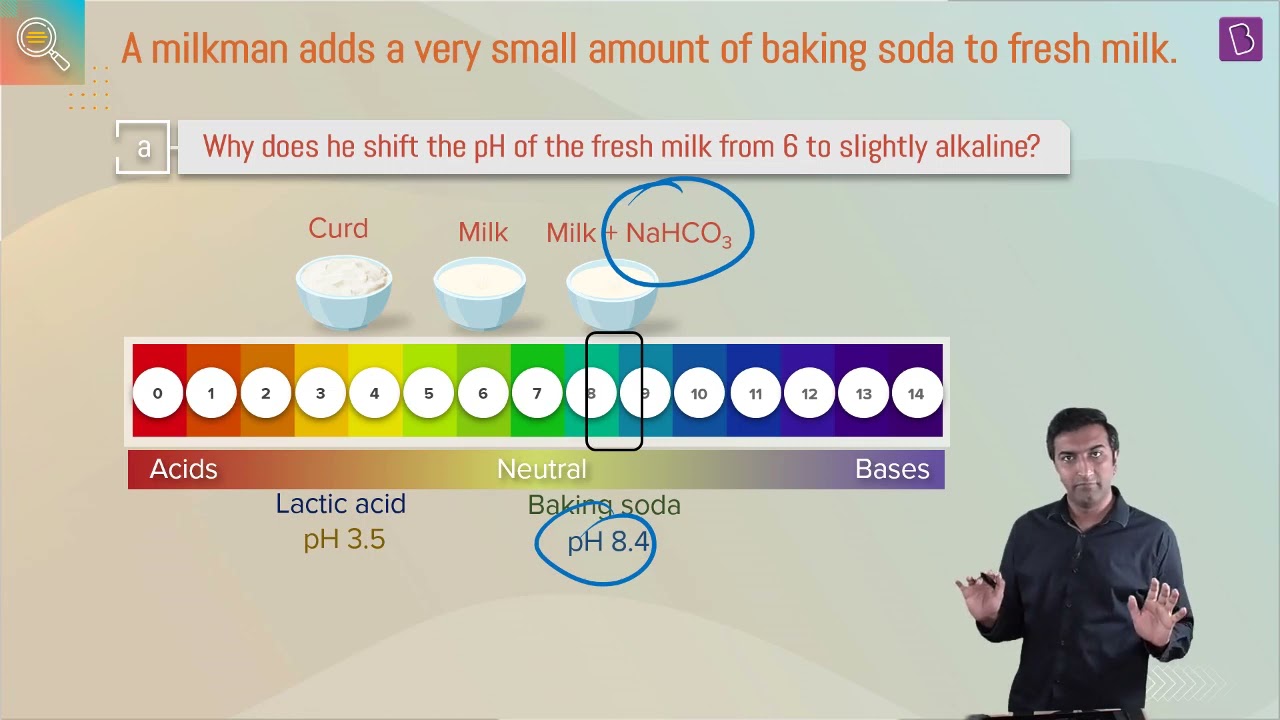
13. Plaster of Paris should be stored in a moisture-proof container. Explain why?
Solution: Plaster of Paris should be stored in moisture-proof container because moisture can affect plaster of Paris by slowing down the setting of the plaster because of hydration. This will turn plaster useless.

14. What is a neutralisation reaction? Give two examples.
Solution: The reaction of the acid + base gives a product of salt + water, which is considered as neutralization reaction.
Examples:
NaOH + HCl → NaCl + H2O
Mg(OH)2 + H2CO3 → MgCO3 + 2H2O
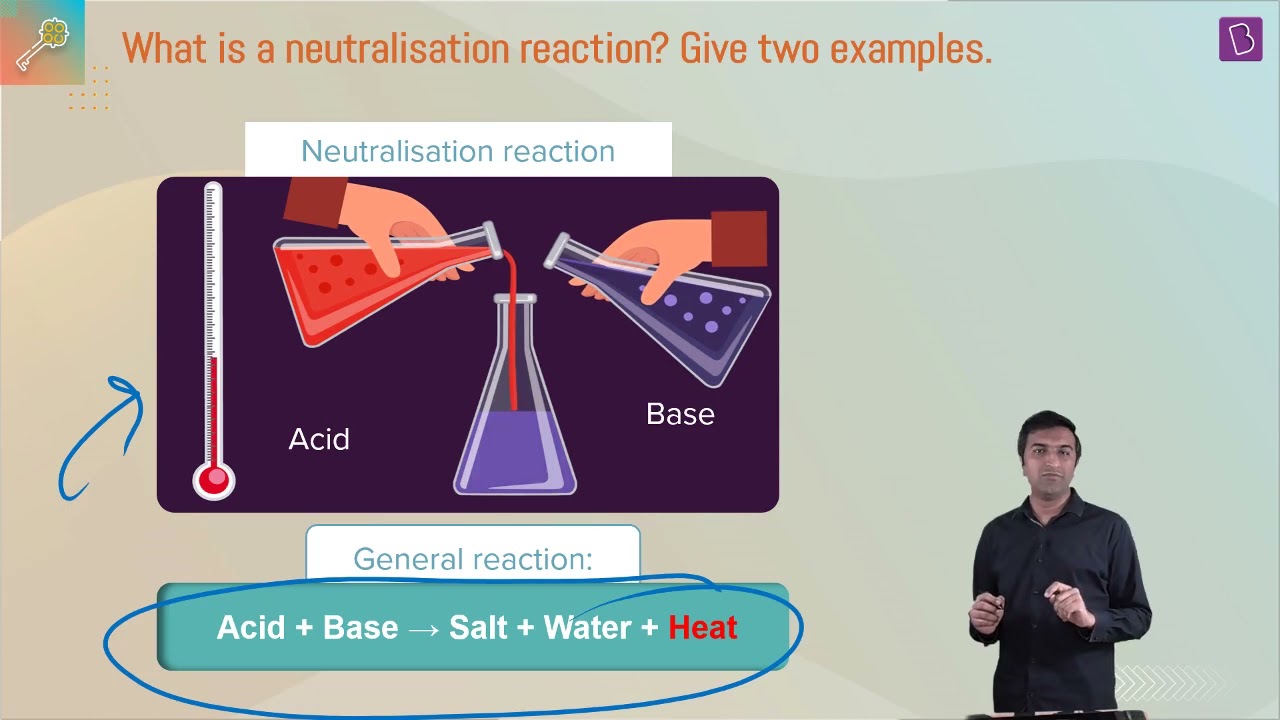
15. Give two important uses of washing soda and baking soda.
Solution:
| Washing soda | Baking soda |
| 1. It is used as an electrolyte | 1. It can be used to test the garden soil for acidity. If bubbles are developed then the soil Is too acidic |
| 2. It can be used domestically as water softener for laundry. | 2. If used on washing car then it will remove dead bug bodies without damaging the colour or the paint on the car. |

| Also Access |
| NCERT Exemplar Solutions for Class 10 Science Chapter 2 |
| CBSE Notes for Class 10 Science Chapter 2 |
Topics included in NCERT Class 10 Science Chapter 2 – Acid, bases and salts
- Understanding the chemical properties of bases and acids
- How do acids and bases react with metals?
- How do metal carbonates and metal hydrogen carbonates react with acids?
- How do acids and bases react with each other?
- The reaction of metallic oxides with acids
- The reaction of non – metallic oxide with base
- What do all acids and bases have in common?
- What happens to an acid or base in a water solution?
- How strong are Acid or base solutions?
- Importance of pH in everyday life
- More about Salts
- Family of salts
- pH of salts
- Chemicals from common salt
NCERT Solutions for Class 10 Chapter 2 Science Acids bases and salts
In this chapter, students will get a hold of basic knowledge on Acids bases and salts. Further, by accessing the Class 10 NCERT Solutions, the various chemical properties of acids, bases and salts and their reaction with metals and non-metals are studied.
Features of NCERT Solutions for Class 10 Chapter 2 Science Acids bases and salts
- There are a lot of practical based questions in this Solution and these types of questions are often asked in CBSE Class 10 Science Term I examination.
- You will encounter questions on a day to day examples of acid bases and salts.
- One can perceive different kinds of reactions involved with acids, bases and salts.
Students can also access NCERT Solutions for Classes 1 to 12 of any subject to learn and revise key concepts at any time.
BYJU’S is India’s top education technology company that believes in a modern learning approach. Our resource materials include NCERT notes, books, animations, videos, info-graphics, NCERT exemplar solutions, sample papers and NCERT Solutions. Our study materials will not only help you in understanding the topic completely but also help you in memorising the topic for a very long period of time.
Frequently Asked Questions on NCERT Solutions for Class 10 Science Chapter 2
List out the concepts discussed in Chapter 2 of NCERT Solutions for Class 10 Science.
1. Understanding the chemical properties of bases and acids
2. How do acids and bases react with metals?
3. How do metal carbonates and metal hydrogen carbonates react with acids?
4. How do acids and bases react with each other?
5. The reaction of metallic oxides with acids
6. The reaction of non – metallic oxide with base
7. What do all acids and bases have in common?
8. What happens to an acid or base in a water solution?
9. How strong are Acid or base solutions?
10. Importance of pH in everyday life
11. More about Salts
12. Family of salts
13. pH of salts
14. Chemicals from common salt
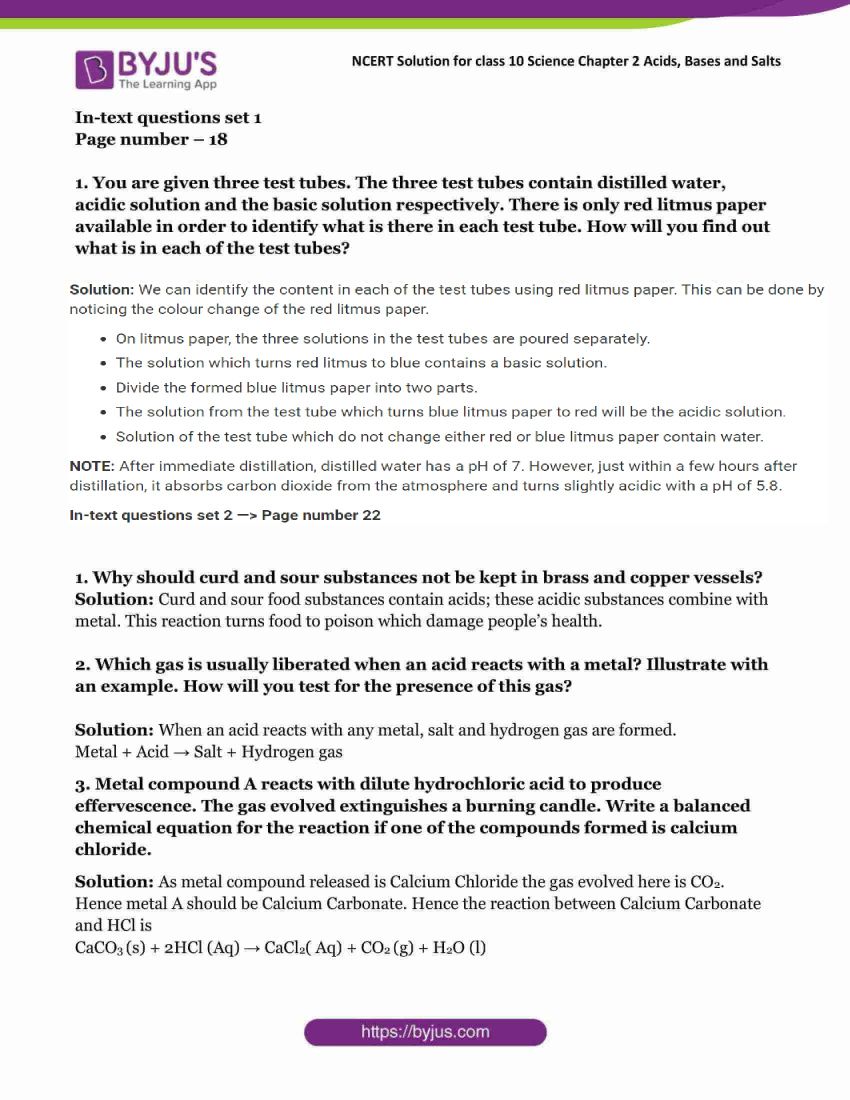
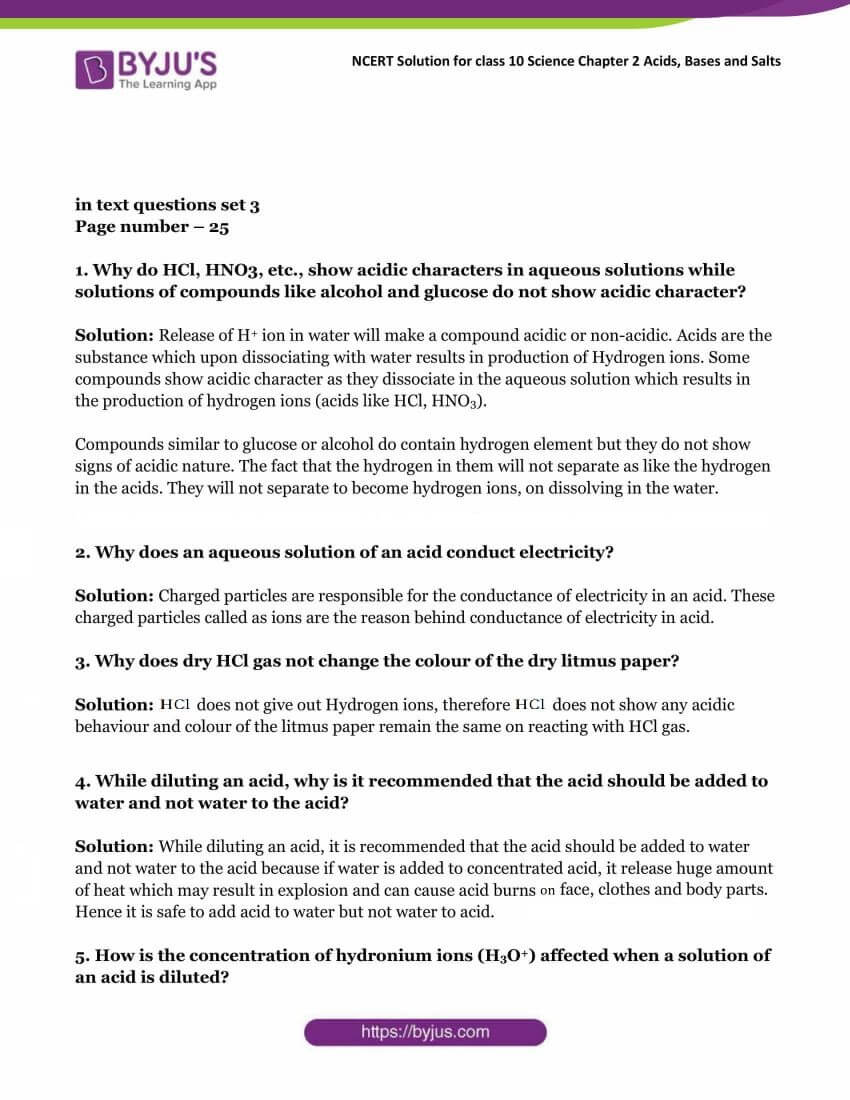
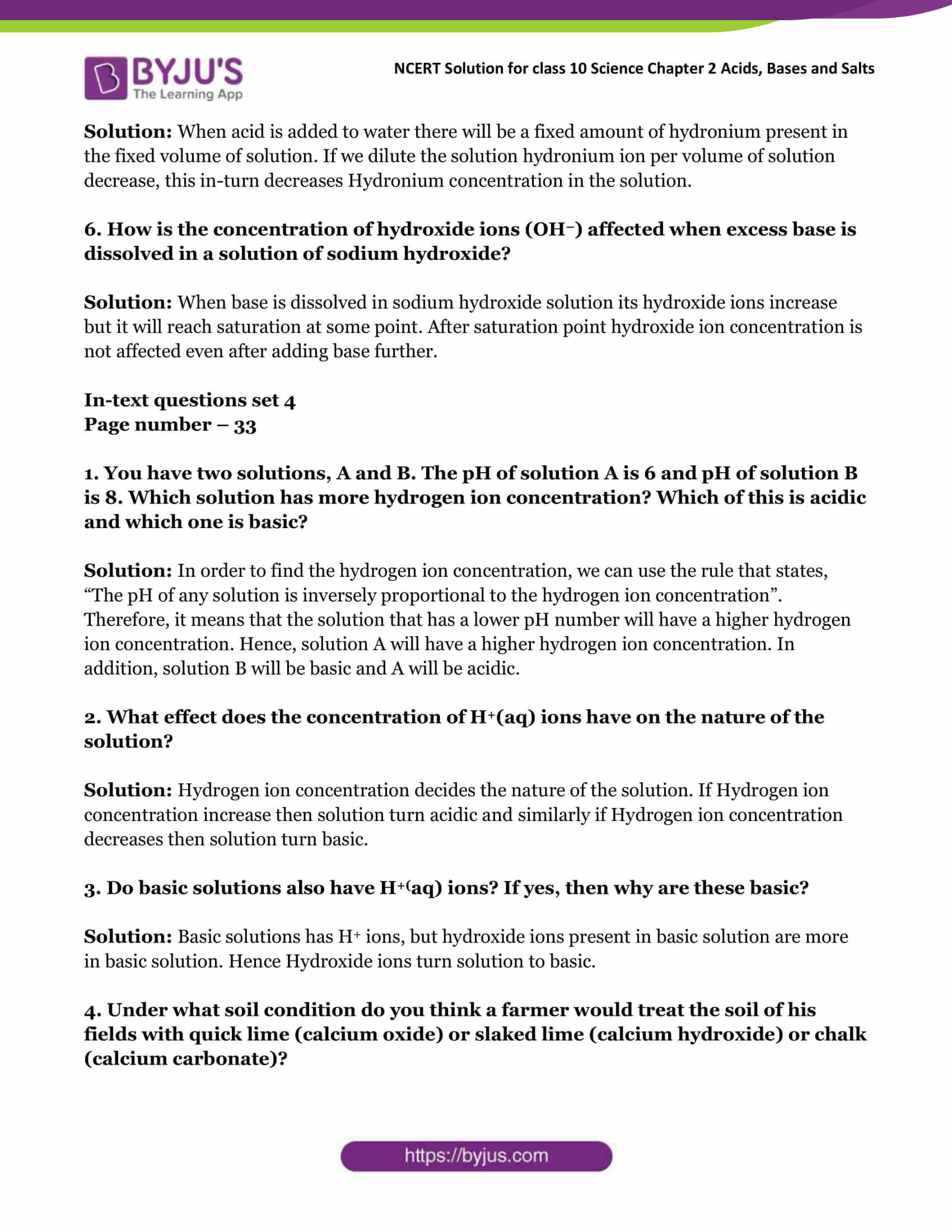

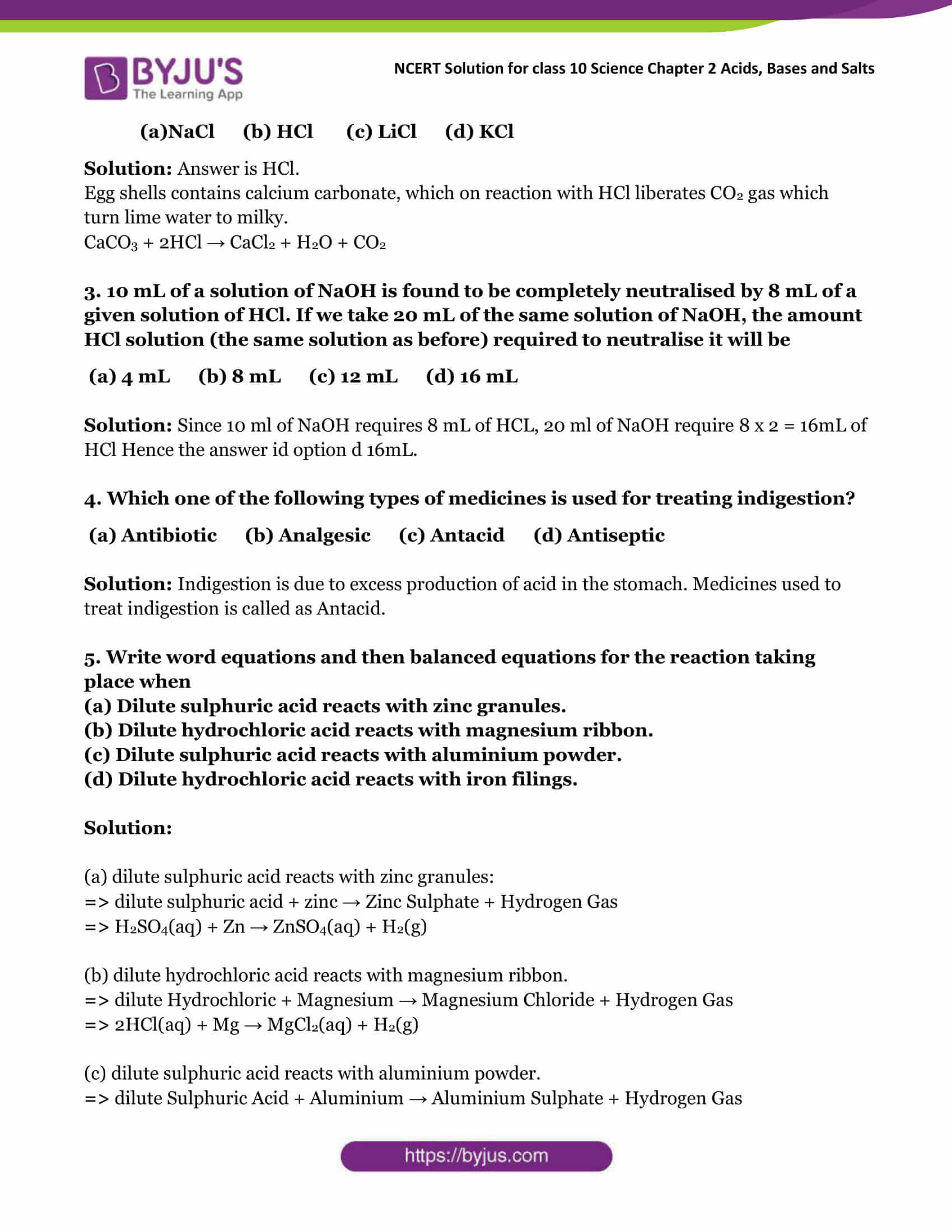

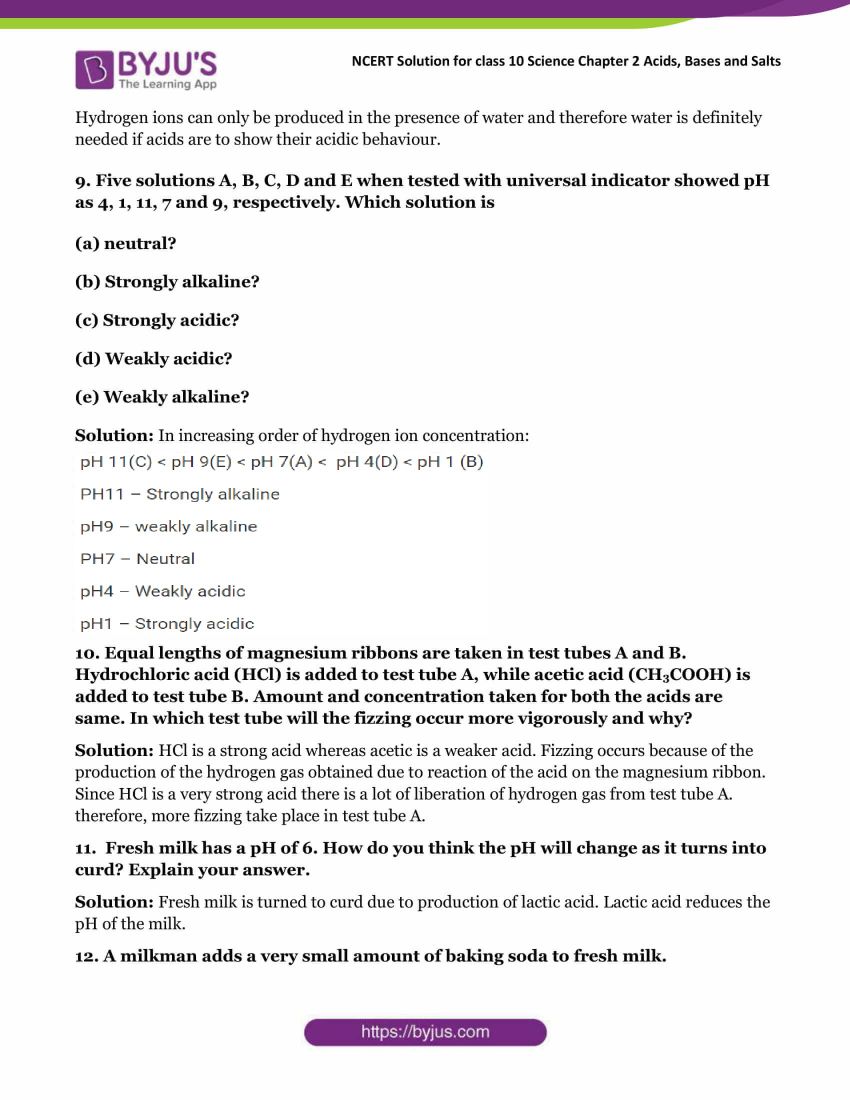



byjus is the best classes this is help me and I need byjus because I weak all the subjects.
Thank you